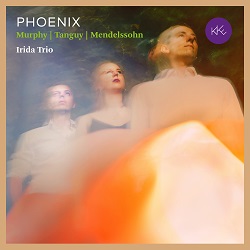Die kanadische Komponistin Kelly-Marie Murphy sagt, der Mythos Phoenix habe sie schon immer fasziniert, weil er im Ende auch den Neuanfang beinhaltet. Der erste Satz ist rhythmisch und schnell und wird in dieser Aufnahme mitreißend gespielt. Nicht weniger packend ist der zweite, der in karger Ruhe das Bild von ein paar Glühwürmchen heraufbeschwören soll, die in der stillen Luft schweben, kurz aufglühen und dann erlöschen. Der dritte Satz beginnt zögernd, wenn sich die Elemente, die den Wiederaufbau besorgen sollen, zusammenfinden, dann aber im Zusammensein die Kraft finden, um Neues erstehen zu lassen. Das Iridia Trio spielt den Satz mit pulsierendem Drive und beendet so ein zeitgenössisches Trio, das einen nachhaltigen Eindruck hinterlässt.
Der französische Komponist Eric Tanguy hat sein Klaviertrio im Jahre 2012 komponiert. Es besteht aus einem 12 Minuten langen Satz mit einem Wechsel von schnellen und langsamen Teilen, wobei das Ganze dramaturgisch sehr clever angelegt ist, mit kräftigen Fortissimo-Eruptionen, virtuosen Steigerungen, oder auch sehr zarten Akkorden.
Das alles wird vom Iridia Trio in einer spannenden Interpretation großartig zum Ausdruck gebracht, vielleicht nicht ganz so intensiv, dafür aber feiner differenziert als in der Aufnahme von David Kadouch, Rosanne Philippens und Edgar Moreau (siehe unten).
Vom 2. Mendelssohn-Trio gibt es viele gute Aufnahmen, und die des Iridia Trios schneidet im Vergleich durchaus nicht schlecht ab. Der kraftvolle erste Satz, Allegro energico e fuoco, wird mit viel Drive effektvoll ausgeformt, und das Andante expressivo überzeugt durch die einfache Natürlichkeit, mit der es gespielt wird. Auch die fulminante Dynamik des Scherzos scheint dem Geist der Musik gut zu entsprechen, und das kunstvolle Finale bekommt mit viel drängendem Drive einen fast symphonischen Charakter.
The Canadian composer Kelly-Marie Murphy says the myth of Phoenix has always fascinated her, because in the end it also contains the new beginning. The first movement is rhythmic and fast and is played in this recording in a rousing manner. No less gripping is the second, which in sparse quiet evokes the image of a few fireflies hovering in the still air, glowing briefly and then going out. The third movement begins hesitantly, when the elements that are to provide the reconstruction come together, but then, in being together, find the strength to let something new arise. The Iridia Trio plays the movement with pulsating drive, so ending a contemporary trio that leaves a lasting impression.
French composer Eric Tanguy composed his piano trio in 2012. It consists of a 12-minute movement with an alternation of fast and slow sections, the whole being very cleverly and dramaturgically structured, with powerful fortissimo eruptions, virtuoso climaxes, or very delicate chords.
All this is magnificently expressed by the Iridia Trio in an exciting interpretation, perhaps not quite as intense, but more finely differentiated than in the recording by David Kadouch, Rosanne Philippens and Edgar Moreau (see below).
There are many good recordings of the 2nd Mendelssohn Trio, and that of the Iridia Trio does not at all compare badly. The powerful first movement, Allegro energico e fuoco, is effectively shaped with plenty of drive, and the Andante expressivo is convincing for the simple naturalness with which it is played. The fulminant dynamics of the Scherzo also seem well suited to the spirit of the music, and the finale takes on an almost symphonic character with plenty of urgent drive.
https://www.pizzicato.lu/die-attraktive-kammermusik-von-eric-tanguy/




















